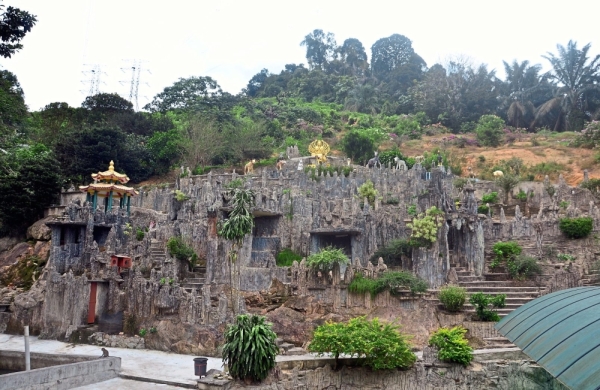
The stone garden at Hwa Kuo Shan Temple in Sedenak is a popular attraction among locals and Singaporeans.
KULAI is more than just Johor Premium Outlets (JPO), say the district’s residents and stakeholders.
Although the district is synonymous with the shopping mall which has become a “must-visit” place since its opening in December 2011, it boasts numerous natural and man-made attractions.
While JPO has put Johor’s smallest district on the regional retail tourism map by attracting more than 4.5 million domestic and foreign visitors looking for discounted off-season fashion items, Kulai District Office assistant district officer Mohd Ezwan Abd Ghani said other attractions in the district include the bamboo garden at Putuo Village, the jagged garden stone landscaping at Sedenak’s Hwa Kuo Shan Temple, the Ayer Bemban waterfalls, D’Cabin Chalet Gunung Pulai, the Sedenak camping site and the Saleng private zoo.
“Kulai has other attractions that visitors should consider exploring apart from shopping at JPO,” said Mohd Ezwan.
Kulai was named after an influx of turtles took refuge in the town after a particularly heavy flood. The town was once known as “gu lai” in the 1920s, which means “turtles are coming” in Chinese.
Chinese mythology tells of a story that the phoenix, gilin (unicorn), dragon and turtle are the most sacred animals but the turtle was the only one of the four that remained.
The term “turtle” commonly covers turtles that generally live in water and tortoises that live on land.
Being an animal believed to have endured longest on earth, the turtle is considered a symbol of wisdom, endurance, wealth and longevity.
Mohd Ezwan said his office will work closely with the state’s tourism and other stakeholders to promote the district’s attractions.
For instance, Kulai has three golf courses for enthusiasts while their families can shop at the retail centre in Indahpura, he added.
“We want to further develop Kulai as an eco-tourism destination as it has the Gunung Pulai Forest Reserve, traditional Malay and Chinese new villages and Felda settlements offering village and homestay experiences to visitors, especially foreigners.”
Kelapa Sawit New Village resident Lim Kee Poh, 67, said the village’s murals have attracted a steady stream of local and foreign tourists to the village since 2013.
“Prior to that, not many outsiders, including Johoreans from other districts, knew about our village. The wall murals have made our village famous,” he said.
Art teacher Hazel Phang, 29, said property owners in the village were initially reluctant to allow the back portion of their houses to be painted.
“Eventually, they agreed when told that the back lane would be transformed through the murals to make
the area vibrant and attractive,” she said.
Phang added that it took three days for volunteers to clean and paint the walls with more than 40 murals along the 800m stretch comprising 80 houses on both sides of the lane.
“We had to consider feng shui elements in the murals such as prosperity, wealth and longevity. Elements like a white tiger is a big no as it is particularly inauspicious.”
Another resident, Phang Hen Nam, 67, hoped that the local authority would consider installing street lights along the lane and cover the drains with concrete slabs.
“This will allow visitors to enjoy the murals in the evenings,” he said.
Flower garland traders at Hwa Kuo Shan Temple, K. Kuppu, 63, and her daughter M. Vijaletchmi, 42, said the place of worship was not only popular with locals but also among Singaporeans.
“The main attractions of the temple are its jagged stone garden landscaping and about 300 monkeys which have turned the garden into their abode,” said Kuppu.
She said the temple was also popular during weekends with out-of-town bridal couples using the temple grounds for their photography sessions.
Kampung Sri Gunung Pulai villager Tukimin Juraimi, 60, hoped that the state government would actively promote Gunung Pulai Forest Reserve, especially to nature lovers.
“There is not much publicity on the place following the landslide although it was reopened in September 2016,” he said.
In December 2001, shutdown was ordered following a landslide that claimed five lives and destroyed four homes in the village.
Tukimin urged the state Forest Department to allow stalls selling food and drinks in the picnic area to operate again.
The district covers Kulai town, Ayer Bemban, Bukit Batu, Kangkar Pulai, Kelapa Sawit, Saleng, Sedenak, Seelong, Senai and Sengkang.
On Jan 1, 2008, the district was renamed Kulaijaya, as Johor’s ninth district. Then, on Aug 28, 2015, Johor Ruler Sultan Ibrahim Ibni Almarhum Sultan Iskandar ordered that the name be reverted to “Kulai”.
~News courtesy of The Star~
No comments:
Post a Comment